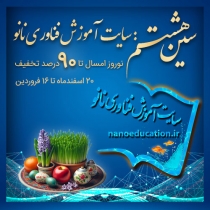کاربرد نانومواد زیستی در تکمیل منسوجات
کاربرد نانومواد زیستی در تکمیل منسوجات
امروزه با استفاده از فناوریهای بینرشتهای، تحول علمی دیگری در بهرهبرداری یکپارچه از قوانین فیزیک، شیمی و فناوری زیستی در جریان است. با توجه به اهمیت خصوصیاتی از قبیل زیست تخریبپذیری، زیست سازگاری و عدم سمیت، استفاده از مواد زیستی برای تولید محصولات با کاربردهای مختلف گسترش یافته است. به طور کلی مواد زیستی، موادی طبیعی یا بشرساخت بوده که با محیط بدن و محیطهای زیستی سازگار میباشند. استفاده از مواد زیستی طبیعی به دلیل زیست سازگاری و زیست تخریبپذیری در فرایند تکمیل منسوجات ضد میکروب، آرایشی - بهداشتی و منسوجات محرک-پاسخگو حائز اهمیت میباشد.
این مقاله شامل سرفصلهای زیر است:
1- مقدمه
2- ویژگیهای مواد زیستی
3- طبقه بندی مواد زیستی
1-3- مواد زیستی طبیعی
1-1-3- سلولز
2-1-3- آلجینات
3-1-3- کلاژن
4-1-3- ابریشم
2-3- مواد زیستی بشرساخت
1-2-3- پلیکاپرولاکتان(PCL)
2-2-3- پلیلاکتیکاسید (PLA)
4- انواع تکمیل منسوجات با استفاده از نانومواد زیستی
1-4- تکمیل ضد میکروب
2-4- استفاده از نانو مواد زیستی برای تولید منسوجات آرایشی
3-4- تکمیل منسوجات با استفاده از پلیمرهای زیستی محرک- پاسخگو
بحث و نتیجهگیری
این مقاله شامل سرفصلهای زیر است:
1- مقدمه
2- ویژگیهای مواد زیستی
3- طبقه بندی مواد زیستی
1-3- مواد زیستی طبیعی
1-1-3- سلولز
2-1-3- آلجینات
3-1-3- کلاژن
4-1-3- ابریشم
2-3- مواد زیستی بشرساخت
1-2-3- پلیکاپرولاکتان(PCL)
2-2-3- پلیلاکتیکاسید (PLA)
4- انواع تکمیل منسوجات با استفاده از نانومواد زیستی
1-4- تکمیل ضد میکروب
2-4- استفاده از نانو مواد زیستی برای تولید منسوجات آرایشی
3-4- تکمیل منسوجات با استفاده از پلیمرهای زیستی محرک- پاسخگو
بحث و نتیجهگیری
لطفا برای مشاهده متن کامل مقاله ابتدا وارد سایت شوید
منابـــع و مراجــــع
۱ - .Gilberto Siqueira, JulienBras.“Cellulose Whiskers versus Microfibrils: Influence of the Nature of the Nanoparticleits Surface Functionalization on the ThermalMechanical Properties of Nanocomposites”, Biomacromolecules, vol.10, pp. 425–432, (2009).
۲ - ArtiGoel,SnehaBhatnagar. “GREEN NANOTECHNOLOGY”, Giap journals, pp.3-4, (2014).
۳ - Widmai e. p.;Raff, H.; Strang, K. t. “Vander ‘s Human Physiology”, 11thEd.McGraw-Hill. ISBN 987-0-07-304962-5, (2003).
۴ - Tran Le Bao Ha, To Minh Quan. "Naturally Derived Biomaterials:PreparationApplication", INTECH, chapter 11, pp. 247-274, (2013).
۵ - Kuen Yong Lee, David J. Mooney. “Alginate: Propertiesbiomedical applications”, Progress in Polymer Science, vol. 37, pp. 106– 126, (2012).
۶ - Chandra, R.,Rustgi , R. “Biodegradable Polymers”, Progress in Polymer Science,Vol.23, pp.1273, (1998).
۷ - Chengjun Zhou, QinglinWu.“Recent Development in Applications of Cellulose Nanocrystals for Advanced Polymer-Based Nanocomposites by Novel Fabrication Strategies”, INTECH, pp. 103-120, (2012).
۸ - Kumar, M.. “A Review of ChitinChitosan Applications”, Reactive& Functional Polymers, vol.46, p p. 1- 7,(2000).
۹ - Tao Jiang, Roshan James, Chapter 5 –“Chitosan as a Biomaterial: Structure, Properties,Applications in Tissue EngineeringDrug Delivery”chapter 5, pp.67-89, (2014).
۱۰ - A. RouhaniS, N. HemmatiNejad, A. Bashari.”Antibacterial Finishing of Cotton Fabric via the Chitosan/TPPSelf-Assembled Nano Layers”, fiberspolymers, vol.15, pp.1908-1914, (2014).
۱۱ - Younsook Shin, Dong IlYoo. “Use of chitosan to improve dyeability of DP-finished cotton (II)”, Journal of Applied Polymer Science, vol.67, pp. 1515–1521, (1998).
۱۲ - Peter M. J. Mahoney, U.S .Patent, US5256477 A, Oct 26, 1993.
۱۳ - Ana P. Gomes,João F. Mano.“Layer-by-layer deposition of antimicrobial polymers on cellulosic fibers: a new strategy to develop bioactive textiles”, Polym. Adv. Technol, 2013
۱۴ - Marian McCord, Challenges in Advanced Nanofiber Wound Dressings Annual Report NTC Project: F09-NS06, (October 2009).
۱۵ - Zheng Zhao, et al. Fabrication of silk fibroin nanoparticles for controlled drug delivery Journal of Nanoparticle Research, 14:736, (2012).
۱۶ - http://www.senteurs.com.sg/lasoie_hist.html, cited on: 2/5/2015.
۱۷ - Coulembier O, Degee P, Hedrick JL, Dubois P. “controlled ring-opening polymerization to biodegradable aliphatic polyester: especially poly (beta-malic acid) derivatives.” ProgrPolymSci, vol.31, pp.723–47, (2006).
۱۸ - Meyers, M. A. “biological Materials: Structure & Mechanical properties”, Progress in Materials Science, Vol. 53, PP.1, (2008).
۱۹ - M Joshi. “Ecofriendly antimicrobial finishing of textile using bioactive agents based on natural product”, Indian Journal of Fiber &Textile Research, vol.34, pp.295-304, (2009).
۲۰ - Mukesh Kumar Singh, V. K. Varun. “Cosmetotextiles: State of Art”, FIBRES &TEXTILES in Eastern Europe, Vol. 19, pp. 27-33, (2011).A. Bashari, N. HemmatinejadA. Pourjavadi, Surface modification of cotton fabric with
۲۱ - dual -responsive PNIPAAm /chitosan nano hydrogel, Polymer Advanced Technology, 24, 9, pp. 797–806, (2013).
۲۲ - Robert J. Mart, Rachel D. Osborne. “Peptide-based stimuli-responsive biomaterials”, Soft Matter, vol.2, pp.822-835, (2006).














